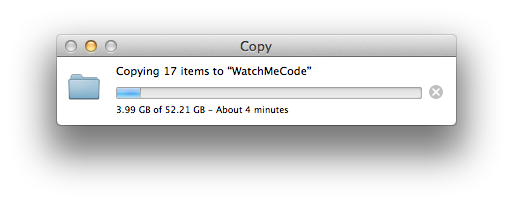High Speed, High Capacity Storage: The 1 Thing Every Screencaster Needs
If there’s one thing every screencaster needs, it’s high speed, high capacity storage for raw materials. I just finished up my 15th episode of WatchMeCode (and have recorded probably another 15 or 20 episodes other than those) – here’s the progress bar copying my raw materials over to my Western Digital Thunderbolt Storage device.

Yes, that’s 52 GIGS of raw material! And yes, it transferred in less than 5 minutes! Seriously, I’ve edited screencasts directly on this thunderbolt drive before, it’s that fast… well, it’s fast enough. I don’t really recommend doing that when you have access to an SSD, like my Macbook Pro Retina has… but I have done it, and it does work. Instead, I leave the raw materials for the episode that I’m currently editing on my internal SSD. Once I’m done, I transfer it over to the storage device for – you guessed it – storage! I also put virtual machines that I don’t currently need on this device, as well as photos and other things that just need storage.
But this brings up a question: why do I need so much storage space, and how did my episode grow to over 50 gigs of raw material?!
Retina Display: File Size And Storage Killer
Normally I use an Apple Thunderbolt monitor. It’s an awesome monitor. But I record my screencasts on my Macbook Pro Retina. I do this because I record in my closet. It’s a large closet, full of clothing and it gives me great sound. So it’s worth hauling my computer in to my closet for this. But I don’t want to haul may monitor in there, too. So I just set up a TV tray and use my laptop directly, with the retina monitor.
The only problem is that the retina monitor is 4x the resolution that I actually need. When I record on the retina and add audio from my Rode Podcaster, I end up with a raw ScreenFlow project of near 18 gigs! It’s gigantic! I always end up with multiple copies of the original, as well. I usually hold one as “original” and use this for the “OH, CRAP!” moments when I break something so badly that I can recover it in my editors. I also create a “preview” video for my screencasts, which creates yet another copy. By the time things are done, I’ve usually got 3 and sometimes 4 copies of the original source. It gets large, fast, but it’s the best way for me to record and work, I’ve found.
Instead of letting these copies eat up 52 gigs of space on my MBPr, though, I have the Western Digital storage device. It’s a 4TB version, but there are 6 and 8 TB versions as well. It is well worth the money to have a good storage device, too. Keeping the raw materials on that device lets me keep all the files that I do need on my hard drive, without worry about space.
